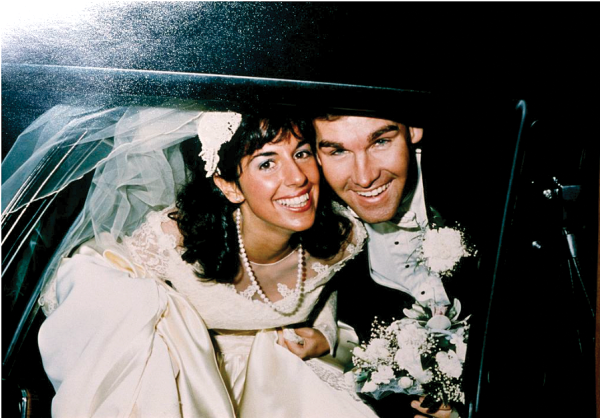December 6, 2023

Carol and Charles Stuart on their wedding day.
Boston Globe columnist and associate editor Adrian Walker has spent the last two years revisiting the 34-year-old Stuart family murder case that exploded out of Boston’s newsrooms late in the evening of Oct. 23,1989 and kept many among the region’s populace intrigued until its dramatic denouement two months later atop a bridge over the Mystic River and in the waters below.
This week, the Globe is giving Walker, who covered the story as a reporter, and his team the space in print and online for an eight-part series on this mind-warping crime, one he describes as “a cataclysmic event when it happened,” and adds, “yet three quarters of people in Boston probably weren’t here in 1989 and, for a lot of people, the story is new.”
The expansive presentation is impressive. The writing is felicitous, the design is fetching and augmented by crisp audio readings, the of-the-time photos and newspaper pages jar the memories of those who followed the story from beginning to end as it happened, and an accompanying podcast fills out the bill.
There is no mistaking that the Globe thinks that this recasting is a very big deal. It made that clear with a subtly patronizing statement up high in its promotion of the series: “You may have heard the story, you may think you know what happened, but you don’t.”
Maybe, maybe not, but a reasonable inference from that assertion is that the newspaper was going to rewrite, or maybe fill in dramatically, a narrative from 34 years ago that a large number of regional residents have locked in their memories in this more or less straightforward manner:
A man named Charles Stuart, or someone close to him, shot and killed his pregnant wife and the child they were expecting, and injured Stuart himself in their car just after they had left a birthing class at a Boston hospital. When Boston police dispatchers were able to talk to the barely coherent Stuart, he told them from the driver’s seat in the car that a Black man had done the shootings and described him and the way he was dressed. The police, or some of them, went out of their minds during their subsequent searches for a person looking like the one Stuart had described, rousting Mission Hill residents in their homes and on the streets of the neighborhood, finally arresting a guy named Willie Bennett. A few months later, Stuart jumped off the Tobin Bridge, a suicide after he had heard that police were looking to arrest him for his role in the murders.
In discussions as the series moves toward deadline, Walker indicated that he was driven to tell this story in updated fashion because those who were violently hassled by police in the heat of the night of the killings and thereafter still have not, after three decades and more, healed from the assaults and need help in doing so.
“That was always the missing part of the story. Those voices have just not been heard to the degree that they needed to be,” Walker told an interviewer. His comment about the number of people living in 2023 Boston who know nothing about the chaos, racial and otherwise, surrounding the Stuart case speaks to his desire to clue them in.
The promotion of the series suggested that bombshells of new information would be dropped on the citizenry with each installment but that doesn’t seem to be the case. Yes, there are additional facts and insights in the text that surprise, one in particular: Readers and viewers are told that 33 people, mostly Stuart relatives and friends, had solid information about who the killer might be in the days and weeks after the crime and yet looked on in associated silence for more than two months as the big city’s leaders and police physically and emotionally abused its own innocent citizens.
For all that, questions remain, one in particular that the Globe team took up extensively: Did Charles have help in the car that night via a third person? The discussion in the series involves witnesses, all deceased, who said they saw a third person in the Stuarts’ car; three doctors who said that the tracing of the three bullets fired in the car showed that Charles couldn’t have shot himself; a consultant who came down on both sides of the question. In the end, the authors concede that with the passage of time, there may be no way to know for sure.
Still, taken as a whole, The Globe’s extensive re-reckoning with a horrific crime that rocked this old city to its core for a while in the long ago gives those who are coming to the story with no personal recollections or expectations insights into how 1989 Boston grappled with old ghosts of race and class as its law enforcement arm aggressively pursued a murderer whose targeted deceit had set off a powder keg stocked with recrimination, bad faith, and ill will.
Thomas F. Mulvoy Jr. is the associate editor of The Reporter and a Dorchester native. He was the managing editor of the Boston Globe during the events covered in the Stuart retrospective.



